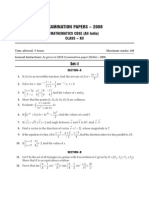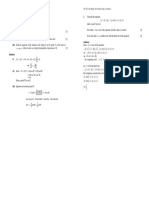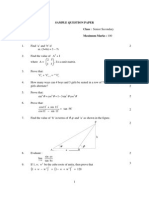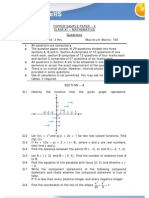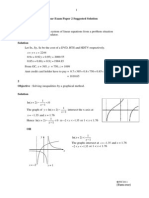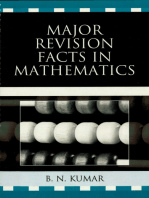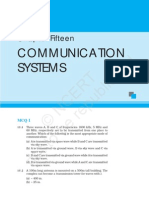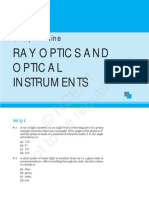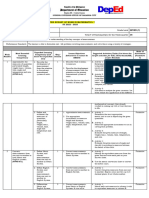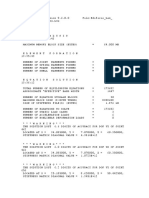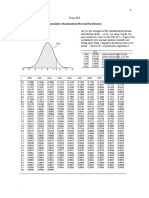Leep 214
Leep 214
Uploaded by
Koyal GuptaCopyright:
Available Formats
Leep 214
Leep 214
Uploaded by
Koyal GuptaCopyright
Available Formats
Share this document
Did you find this document useful?
Is this content inappropriate?
Copyright:
Available Formats
Leep 214
Leep 214
Uploaded by
Koyal GuptaCopyright:
Available Formats
Set-II
DESIGN OF THE QUESTION PAPER
MATHEMATICS CLASS XII
The weightage of marks over different dimensions of the question paper shall be as follows:
(A)Weightage to different topics/content units Topic Marks Relations and functions 10 Algebra 13 Calculus 44 Vectors and three-dimensional geometry 17 Linear programming 06 Probability 10 Total 100 (B) Weightage to different forms of questions: S.No. Form of Questions Marks for Total No. of Total each Question Questions Marks 1. MCQ/Objective type/VSA 01 10 10 2. Short Answer Questions 04 12 48 3. Long Answer Questions 06 07 42 Total 29 100 (C) Scheme of Option There is no overall choice. However, an internal choice in four questions of four marks each and two questions of six marks each has been provided. Blue Print Units/Type of Question MCQ/VSA S.A. L.A. Total Relations and functions 2(2) 8 (2) 10 (4) Algebra 3 (3) 4 (1) 6 (1) 13 (5) Calculus 2 (2) 24(6) 18(3) 44 (11) Vectors and 3-dimensional geometry 3 (3) 8 (2) 6 (1) 17 (6) Linear programming 6 (1) 6 (1) Probability 4 (1) 6 (1) 10 (2) Total 10 (10) 48 (12) 42 (7) 100 (29) S.No. 1. 2. 3. 4. 5. 6.
Time : 3 Hours Max. Marks : 100
DESIGN OF THE QUESTION PAPER SET-II
337
SectionA
Choose the correct answer from the given four options in each of the Questions 1 to 3. 1. If is a binary operation given by : R R R, a b = a + b2, then 25 is (A) 52 (B) 23 (C) 64 (D) 13
2.
3 1 If sin1 : [1, 1] , is a function, then value of sin1 is 2 2 2
(A)
(B)
(C)
5 6
(D)
7 6
3.
9 6 2 3 3 0 Given that = . Applying elementary row transformation 3 0 1 0 1 2 R1 R12 R2 on both sides, we get
3 6 2 3 1 4 (A) = 3 0 1 0 1 2
3 6 2 3 3 0 (C) = 3 0 1 0 3 2
3 6 0 3 3 0 (B) = 3 0 1 0 1 2
3 6 4 3 3 0 (D) = 3 0 1 0 1 2
4. 5.
If A is a square matrix of order 3 and |A| = 5, then what is the value of |Adj. A|? If A and B are square matrices of order 3 such that |A| = 1 and |B| = 4, then what is the value of |3(AB)|?
6.
d y 3 d 2 y 2 The degree of the differential equation 1 + d x = 2 is_______. dx
Fill in the blanks in each of the Questions 7 and 8: 7.
dy The integrating factor for solving the linear differential equation x d x y = x2
is_______.
338
MATHEMATICS
8. 9. 10.
i j The value of is_______.
What is the distance between the planes 3x + 4y 7 = 0 and 6x + 8y + 6 = 0? If a is a unit vector and (x a) . (x + a) = 99, then what is the value of | x |?
SectionB
11. Let n be a fixed positive integer and R be the relation in Z defined as a R b if and only if a b is divisible by n, a, b Z. Show that R is an equivalence relation. Prove that cot17 + cot18 + cot118 = cot13. OR
1 1 1 2 , 3 > x> 3. Solve the equation tan (2 + x) + tan (2 x) = tan 3
12.
x+2 x+6 13.
x 1
Solve for x, x + 6 x 1 x + 2 = 0 x 1 x + 2 x + 6 OR
1 2 If A = and B = 3 4 1 1 3 2 2 , verify that (AB) = B A . 3
14.
Determine the value of k so that the function:
k .cos 2 x 4x , f (x) = 5,
if x
4 if x = 4
is continuous at x =
. 4
DESIGN OF THE QUESTION PAPER SET-II
339
15.
If y = e a cos x , show that (1 x2)
d2 y x dy a 2 y = 0 . d2 x dx
16.
Find the equation of the tangent to the curve x = sin3t , y = cos2t at t =
. 4 , is 2
Find the intervals in which the function f (x) = sin4 x + cos4 x, 0 < x < strictly increasing or strictly decreasing. 17. Evaluate
sin 4 x cos3 x dx
18.
Evaluate
2x
3x + 1 dx 2x + 3
OR
Evaluate 19.
x.(log x)
dx
Find a particular solution of the differential equation
x x y 2y e dx + (y 2 x e y ) dy = 0, given that x = 0 when y =1.
20.
j j If a = 2 i 2 + k , b = i + 2 3 k and c = 2 i + 4 k , then find the projection j of b + c along a .
21.
Determine the vector equation of a line passing through (1, 2, 4) and perpendicular to the two lines r = (8 i 16 + 10 k ) + (3 i 16 + 7 k ) and j j j j (15 i + 29 + 5 k ) + (3 i + 8 5k ) .
22.
There are three coins. One is a biased coin that comes up with tail 60% of the times, the second is also a biased coin that comes up heads 75% of the times and the third is an unbiased coin. One of the three coins is chosen at random and tossed, it showed heads. What is the probability that it was the unbiased coin?
340
MATHEMATICS
SECTIONC 4 1 2 1 Find A1, where A = 3 1 3 1 . Hence solve the following system of 2
23.
equations 4 x + 2 y + 3 z = 2, x + y + z = 1, 3 x + y 2 z = 5, OR Using elementary transformations, find A1, where 1 2 2 A = 1 3 0 0 2 1 24. Show that the semi-vertical angle of the cone of maximum volume and of given slant height is tan 1 2 . 25. 26. Evaluate
(3 x 2 + 2 x + 5) dx by the method of limit of sum.
Find the area of the triangle formed by positive x-axis, and the normal and tangent to the circle x2 + y2 = 4 at (1,
3 ), using integration.
27.
Find the equation of the plane through the intersection of the planes x + 3 y + 6 = 0 and 3 x y 4z = 0 and whose perpendicular distance from origin is unity. OR Find the distance of the point (3, 4, 5) from the plane x + y + z = 2 measured parallel to the line 2 x = y = z.
28.
Four defective bulbs are accidently mixed with six good ones. If it is not possible to just look at a bulb and tell whether or not it is defective, find the probability distribution of the number of defective bulbs, if four bulbs are drawn at random from this lot.
DESIGN OF THE QUESTION PAPER SET-II
341
29.
A furniture firm manufactures chairs and tables, each requiring the use of three machines A, B and C. Production of one chair requires 2 hours on machine A, 1 hour on machine B and 1 hour on machine C. Each table requires 1 hour each on machine A and B and 3 hours on machine C. The profit obtained by selling one chair is Rs 30 while by selling one table the profit is Rs 60. The total time available per week on machine A is 70 hours, on machine B is 40 hours and on machine C is 90 hours. How many chairs and tables should be made per week so as to maximise profit? Formulate the problems as a L.P.P. and solve it graphically.
342
MATHEMATICS
Marking Scheme
Section-A
1. (B) 4. 25 8. 2 2. (D) 5. 108 9. 2 Units 3. (B) 6. 2 10. 10 7.
1 x
Marks 1 10 = 10
Sections-B
11. (i) Since a R a, a Z, and because 0 is divisible by n, therefore R is reflexive. 1
(ii) a R b a b is divisible by n, then b a, is divisible by n, so b R a. Hence R is symmetric. 1 (iii) Let a R b and b R c, for a,b,c, Z. Then a b = n p, b c = n q, for some p, q Z Therefore, a c = n (p + q) and so a R c. Hence R is reflexive and so equivalence relation. LHS = tan1 1 1 1
12.
1 1 1 + tan1 + tan1 7 8 18
1 1 + 1 1 1 15 8 1 7 = tan + tan1 = tan + tan1 1 1 55 18 18 1 . 7 8 3 1 + 11 18 3 1 65 = tan1 + tan1 = tan1 3 1 = tan1 11 18 195 1 11 18
= tan1
1 = cot13 = RHS 3
OR
DESIGN OF THE QUESTION PAPER SET-II
343
Since
tan1 (2 + x) + tan1 (2 x) = tan1
2 3
1
Therefore,
(2 + x) + (2 x) 2 tan1 1 (2 + x) (2 x) = tan1 3
Thus
4 2 = x 3 3
2
1 1 x 1
x2 = 9 x = 3 x+2 x+6
13.
Given, x + 6 x 1 x + 2 = 0 x 1 x + 2 x + 6
R 2 R 2 R1 Using R R R , we get 3 3 1
x + 2 x + 6 x 1 4 7 3 =0 3 4 7
C2 C2 C1 Using C C C , we get 3 3 1
x+2 4 3
4 3 11 1 = 0 1 10
Therefore, (x + 2) (111) 4 (37) 3 (37) = 0 which on solving gives x =
7 3
OR
1 2 1 1 AB = 3 4 3 2
2 7 = 3 15
3 5
4 6
344
MATHEMATICS
Therefore,
7 15 3 5 LHS = (AB) = 4 6 7 15 3 3 5 and hence LHS = RHS = 4 4 6
3 1 1 2 1 RHS = B A = 2 3 2 1+1 Since f is continous at x =
14.
, we have lim f (x) = 5. x 4 4
k cos 2( y ) k .cos2 x 4 lim f ( x) lim = lim y 0 = x 4 x , where x = y, Now x 4 4( y ) 4 4 4
lim k .cos ( 2 2 y ) lim (k sin2 y ) k = = = y 0 + 4y y 0 2. 2 y 2
Therefore,
k = 5 k = 10. 2
1
15.
a cos y= e
d y a cos1 x ( a) =e dx 1 x2
Therefore,
1 x2
dy = a y.......(1) dx
Differentiating again w.r.t. x, we get
DESIGN OF THE QUESTION PAPER SET-II
345
1 x2
d2y x dy ady = 2 dx dx 2 dx 1 x d2y dy dy x = a 1 x2 2 dx dx dx
(1 x 2 )
= a ( ay) Hence
(1 x 2 )
[from 1]
d2y dy x a2 y = 0 . 2 dx dx
16.
dx dy = + 3cos3t , = 2sin 2t dt dt
2sin dy 2 2sin 2t 2 2 dy 2 = = = Therefore, ,and = 1 dx 3cos3t 3 dx t = 3cos3 3.( ) 4 4 2
1 = and y = cos2t = cos 2 4 2 = 0.
Also x = sin3t = sin 3
Therefore,
1 ,0 Point is 2
2 2 x 1 2 3
Hence, equation of tangent is y 0 =
2 2 x 3y 2 = 0
1 OR
346
MATHEMATICS
f (x) = 4 sin3x cosx 4 cos3x sinx = 4 sinx cosx (cos2x sin2x) = sin 4x . Therefore, f (x) = 0 4x = n x= n 1
4
1
Now, for 0 < x < f (x) < 0
, 4
Therefore, f is strictly decreasing in ( 0,
) 4
, ) 4 2
Similarly, we can show that f is strictly increasing in (
6 0
17.
I=
sin 4 x cos3 x dx
= 6 sin 4 x ( 1 sin 2 x) cos x dx
0
4 2 = 02 t (1 t ) d t , where sin x = t 1
1 1
1 2 0
t5 t7 2 (t t ) dt = 5 7 0
4 6
5 7
1 1 1 1 1 1 1 23 = = = 5 2 7 2 32 5 28 4480
DESIGN OF THE QUESTION PAPER SET-II
347
18.
I=
2x
3x + 1 dx = 2x + 3
3 5 (4 x 2) + 4 2 dx 2 2x 2x + 3
3 4x 2 5 1 dx 2 x 2 2 x + 3 dx + 4 2 3 4 x x+ 2
dx 3 5 = log | 2 x 2 2 x + 3 | + 2 2 4 4 1 5 x + 2 2
3 5 2 2x 1 = log | 2 x 2 2 x + 3 | + tan 1 +c 4 4 5 5
1 2
1 2
3 5 2x 1 = log | 2 x 2 2 x + 3 | + tan 1 +c 4 2 5
OR
I = x(log x) 2 . dx = (log x) 2 x dx = (log x) 2 x2 1 x2 2log x dx 2 x 2
x2 (log x) 2 log x. x dx 2
1 2 1 2
x2 x2 1 x2 (log x)2 log x. . dx x 2 2 2
348
MATHEMATICS
x2 x2 x2 (log x) 2 log x + + c 2 2 4
19.
Given differential equation can be written as
x y
dx 2 x e y = x dy 2y. e y
1 2 1 2 1 2
x dx dv Putting y = v x = vy d y = v + y d y
dv 2 v yev y 2v ev 1 = = dy 2yev 2ev
Therefore, v + y
dv 2 vev 1 = v dy 2ev
Hence 2 ev dv =
dy y
1
2 ev = log | y | + c
or 2 e y = log | y | + c when x = 0, y=1
x
C=2
Therefore, the particular solution is 2 e = log | y | + 2
x y
1 2
DESIGN OF THE QUESTION PAPER SET-II
349
20.
j j b + c = (i + 2 3 k ) + (2 i + 4 k ) = 3 i + + k j a = 2i 2 + k j (b + c ). a is |a|
Projection of (b + c ) along a =
6 2 +1 4 + 4 +1 = 5 units 3
1+1
21.
A vector perpendicular to the two lines is given as
i j k (3 i 16 + 7 k ) (3 i + 8 5 k ) = 3 16 7 j j 3 8 5
= 24 i + 36 + 72 k or 12(2 i + 3 + 6 k ) j j
1 2
Therefore, Equation of required line is r = (i + 2 4 k ) + ( 2 i + 3 + 6 k ) j j 22. Let E1: selection of first (biased) coin E2: selection of second (biased) coin E3: selection of third (unbiased) coin P(E1) = P(E2) = P(E3) = 1
1 2
1 3
1 2
Let A denote the event of getting a head
350
MATHEMATICS
A 1 A A 75 40 Therefore, P E = , P E = 100 , P E = 1 100 2 3 2
A P (E 3 ) P E E3 P 3 = A A A A P (E1 ) P + P (E 2 ) P + P (E 3 ) P E1 E2 E3
1 2
1 2
1 1 . 10 3 2 = = 1 40 1 75 1 1 33 . + . + . 3 100 3 100 3 2
SECTIONC 23. |A| = 4 (3) 1 (7) + 3 (1) = 12 + 7 3 = 8 A11 = 3 A21 = 5 A31 = 2 A12 = 7 A13 = 1
1 2
1 1
1 2
A22 = 17 A23 = 1 A32 = 2 A33 = 2
5 2 3 1 Therefore, A1 = 7 17 2 8 2 1 1
1 2
Given equations can be written as 4 2 3 1 1 1 3 1 2
x y = z
2 1 5
DESIGN OF THE QUESTION PAPER SET-II
351
A. X = B X = (A )B
= (A 1 ) B
x 1 y = z 8 1 2 3 7 5 17 1 1 2 2 2 5
1 6 +7 5 = 4 2 1 3 = 10 17 5 = 12 = 2 8 8 4 +2 +10 = 1
1 2
1 3 Therefore, x = , y = , z = 1 2 2
OR 1 2 2 1 0 0 Writing A = 1 3 0 = 0 1 0 A 0 2 1 0 0 1
1 2 2 1 0 0 R 2 R 2 + R 1 0 5 2 = 1 1 0 A 0 2 1 0 0 1 1 2 2 1 0 0 R 2 R 2 + 2R 3 0 1 0 = 1 1 2 A 0 2 1 0 0 1
1 2
1 2
352
MATHEMATICS
1 2 2 1 0 0 R3 R3 + 2 R 2 0 1 0 = 1 1 2 0 0 1 2 2 5 1 2 R1 R1 + 2 R 3 0 1 0 0 1 0 R1 R1 2 R 2 0 1 0 0 0 5 4 10 0 = 1 1 2 A 1 2 2 5 0 3 2 6 0 = 1 1 2 A 1 2 2 5
3 2 6 = 1 1 2 2 2 5
1 2
1 2 24. Volume v = v = r h 3
l2 = h2 + r2 v=
1 2 1
2 1 2
1 1 (l2 h2) h = (l2h h3) 3 3 1 1 1 2
dv 2 = (l 3h 2 ) = 0 dh 3
l=
3h , r =
r = 2 h
2h
tan =
DESIGN OF THE QUESTION PAPER SET-II
353
= tan1 2
d 2v = 2h < 0 dh 2
Therefore, 25.
3
v is maximum
3
I = (3x 2 + 2 x + 5) dx = f ( x) dx
1 1
= lim h [ f (1) + f (1 + h) + f (1 + 2h) + ....... + f (1 + (n 1)h) ] ...... (i) h o
where h = Now
3 1 2 = n n
f (1) = 3 + 2 + 5 = 10
f (1 + h) = 3 + 3h 2 + 6h + 2 + 2h + 5 = 10 + 8h + 3h 2
1 2
f (1 + 2h) = 3 + 12h 2 + 12h + 2 + 4h + 5 = 10 + 8.2.h + 3.22.h 2
f (1 + (n 1) h) = 10 + 8(n 1) h + 3(n 1)2 .h 2
n (n 1) n (n 1)(2n 1) lim + 3h 2 I = n h 10n + 8h 2 6
2 n 16 n (n 1) 12 n (n 1) (2n 1) + 2 10n + n 2 6 n
1 2
lim = n
354
MATHEMATICS
lim = n
2 n
2 10n + 8(n 1) n (n 1) (2n 1)
1 2
1 1 1 lim = n 2 10 + 8(1 ) + 2(1 ) (2 ) n n n
= 2 [10 + 8 + 4] = 44 Equation of tangent to x2 + y2 = 4 at (1, 3) is
4 x 3
1 2
26.
x + 3 y = 4. Therefore, y =
1 1
Equation of normal y = 3 x
Therefore, required area =
3 xd x +
4 x dx 3
x2 1 x2 = 3 + 4x 2 0 2 1 3
= 27.
3 1 7 3 3 3 + 8 2 = 2 + 2 = 2 3 sq. units 2 3
Equation of required plane is (x + 3y + 6) + (3x y 4z) = 0 1
1 2
1 2
(1 + 3 ) x + (3 ) y 4 z + 6 = 0
DESIGN OF THE QUESTION PAPER SET-II
355
Perpendicular distance to the plane from origin is
6
Therefore, or or
(1 + 3 ) + (3 )2 + (4 )2
2
=1
1 2
36 = 1+ 9 2 + 6 + 9 + 2 6 + 16 2 26 2 = 26 = 1 Equations of required planes are 4 x + 2y 4 z + 6 = 0 and 2x + 4y + 4z + 6 = 0 or 2x + y 2z + 3 = 0 and x 2 y 2z 3 = 0 OR
x y z = = 1 1 1 2
1 1
1 2
Equaiton of line is 2x = y = z i.e.
or
x y z = = 1 2 2
356
MATHEMATICS
Equation of line P Q is
x3 y 4 z 5 = = = 1 2 2
Q ( + 3, 2 + 4, 2 + 5) lies on plane. Therefore,
+ 3 + 2 + 4 + 2 + 5 2 = 0
or 5 = 10 gives = 2 which gives the coordinates of Q(1, 0, 1) 1
1 2
Therefore, P Q = 4 + 16 + 16 = 6 units 28. Let x denotes the number of defective bulbs
P (X = 0) =
6 10
1 2
C4 6.5 .4.3 1 = = C4 10.9. 8.7 14
P (X = 1) =
C3 4 C1 6.5.4.4. 8 = 4= 10 C4 10.9.8.7 21 C2 6 C2 6.5.4.3 3 = .6 = 10 C4 10.9. 8.7 7 C1 6 C3 6.4.3.2 4 = .4 = 10 C4 10.9. 8.7 35
P (X = 2) =
P (X = 3) =
4 C 4.3.2.1 1 P (X = 4) = 10 4 = = C 4 10.9.8.7 210
Therefore, distribution is
DESIGN OF THE QUESTION PAPER SET-II
357
P (X) :
1 14
8 21
3 7
4 35
1 210
29.
Let number of chairs to be made per week be x and tables be y Thus we have to maximise P = 30 x + 60 y Subject to 2 x + y 70 x + y 40 x + 3y 90 x 0y 0 Vertices of feasible region are 2 2
A (0,30), B (15, 25), C (30,10), D (35, 0) P (at A) = 30 (60) = 1800 P (at B) = 30 (15 + 50) = 1950
1 2
358
MATHEMATICS
P (at C) = 30 (30 + 20) = 1500 P (at D) = 30 (35) = 1050 P is Maximum for 15 chairs and 25 tables.
1 2
You might also like
- ATI TEAS Calculation Workbook: 300 Questions to Prepare for the TEAS (2024 Edition)From EverandATI TEAS Calculation Workbook: 300 Questions to Prepare for the TEAS (2024 Edition)No ratings yet
- NYJC JC 2 H2 Maths 2011 Mid Year Exam Solutions Paper 1Document10 pagesNYJC JC 2 H2 Maths 2011 Mid Year Exam Solutions Paper 1jimmytanlimlongNo ratings yet
- Introducing Permutations and Factorial Notation: Learn About The MathDocument8 pagesIntroducing Permutations and Factorial Notation: Learn About The MathhareshNo ratings yet
- Maths Model Test Paper For Summative Assessment - 1Document13 pagesMaths Model Test Paper For Summative Assessment - 1Apex InstituteNo ratings yet
- Blue Print: Class Xii Maths: Model Question PaperDocument14 pagesBlue Print: Class Xii Maths: Model Question Paperapi-243565143No ratings yet
- Sample Question Paper Subject: Mathematics Class: Senior Secondary Time: 3 Hours Maximum Marks: 100Document22 pagesSample Question Paper Subject: Mathematics Class: Senior Secondary Time: 3 Hours Maximum Marks: 100Amar KumarNo ratings yet
- Iit Jee 2004 MathDocument7 pagesIit Jee 2004 MathLokesh KumarNo ratings yet
- 12th Maths Exam Paper (2008-2012) FinalDocument430 pages12th Maths Exam Paper (2008-2012) FinalAdityas AravindNo ratings yet
- Math Question Papers For Class 12Document155 pagesMath Question Papers For Class 12GopalSharma100% (1)
- Kcet - Mathematics - 2016: Version Code: C - 3Document13 pagesKcet - Mathematics - 2016: Version Code: C - 3Kamalesh ShenoyNo ratings yet
- Iitjee 2004 MathDocument7 pagesIitjee 2004 MathKitti WongtuntakornNo ratings yet
- K.V. JMO 2014 SolutionsDocument11 pagesK.V. JMO 2014 SolutionsPremMehtaNo ratings yet
- HCI 2008 Promo W SolutionDocument12 pagesHCI 2008 Promo W SolutionMichael CheeNo ratings yet
- 2012 TJC MA H2 P1 Prelim SolnDocument8 pages2012 TJC MA H2 P1 Prelim Solnfocuscharade_8247490No ratings yet
- 2015 AJC Prelim Paper 1 QnsDocument7 pages2015 AJC Prelim Paper 1 QnsYing Ru ChuaNo ratings yet
- Iit - Jee Model Grand Test - Ii Paper - 1 SolutionsDocument6 pagesIit - Jee Model Grand Test - Ii Paper - 1 SolutionsSayan Kumar KhanNo ratings yet
- K.V. JMO 2014 SolutionsDocument11 pagesK.V. JMO 2014 SolutionsPremMehtaNo ratings yet
- Sample Question Paper Subject: Mathematics Class: Senior Secondary Time: 3 Hours Maximum Marks: 100Document22 pagesSample Question Paper Subject: Mathematics Class: Senior Secondary Time: 3 Hours Maximum Marks: 100Aathira GopiNo ratings yet
- Aieee Paper 2008Document30 pagesAieee Paper 2008Ravi LorventNo ratings yet
- Topper Sample Paper - 4 Class Xi - Mathematics Questions Time Allowed: 3 Hrs Maximum Marks: 100Document17 pagesTopper Sample Paper - 4 Class Xi - Mathematics Questions Time Allowed: 3 Hrs Maximum Marks: 100guptafamily1992No ratings yet
- Iitjee2008 1Document23 pagesIitjee2008 1Lokesh KumarNo ratings yet
- Chapter 2: Trigonometric FunctionsDocument10 pagesChapter 2: Trigonometric FunctionsSaidin AhmadNo ratings yet
- Answ Er Key: Hints & Solutions (Year-2009)Document24 pagesAnsw Er Key: Hints & Solutions (Year-2009)sabhari_ramNo ratings yet
- Form 5 Additional Maths NoteDocument10 pagesForm 5 Additional Maths NoteEric WongNo ratings yet
- IIT JEE 2006 MathsDocument14 pagesIIT JEE 2006 MathsKainshk GuptaNo ratings yet
- JJC JC 2 H2 Maths 2011 Mid Year Exam SolutionsDocument14 pagesJJC JC 2 H2 Maths 2011 Mid Year Exam SolutionsjimmytanlimlongNo ratings yet
- Kvpy Paper XiiDocument25 pagesKvpy Paper XiiVishank RustagiNo ratings yet
- Studymate Solutions To CBSE Board Examination 2013-2014: MathematicsDocument13 pagesStudymate Solutions To CBSE Board Examination 2013-2014: MathematicsRajNo ratings yet
- Iit Jee 2008 Paper 1Document23 pagesIit Jee 2008 Paper 1Sai NarendraNo ratings yet
- Model Test Paper - 2 (Solved) : Maximum Marks: 90 Maximum Time: 3 HoursDocument10 pagesModel Test Paper - 2 (Solved) : Maximum Marks: 90 Maximum Time: 3 Hoursrita soniNo ratings yet
- 2010 JJC Prelim P2 SolutionsDocument12 pages2010 JJC Prelim P2 Solutionsnothingtodo1992No ratings yet
- PJC JC 2 H2 Maths 2011 Mid Year Exam Solutions Paper 2Document10 pagesPJC JC 2 H2 Maths 2011 Mid Year Exam Solutions Paper 2jimmytanlimlongNo ratings yet
- MHT CET 2016 Version 11Document16 pagesMHT CET 2016 Version 11JitNo ratings yet
- Math 3 With SolutionsDocument5 pagesMath 3 With SolutionsDiane BasilioNo ratings yet
- TJC JC 2 H2 Maths 2011 Mid Year Exam SolutionsDocument12 pagesTJC JC 2 H2 Maths 2011 Mid Year Exam SolutionsjimmytanlimlongNo ratings yet
- Mathematics Sample Paper Solutions Section-ADocument19 pagesMathematics Sample Paper Solutions Section-APoonamBhardwajNo ratings yet
- Solution All PaperDocument21 pagesSolution All PaperSanjay Verma75% (4)
- IJSO DPP 6 MathsDocument3 pagesIJSO DPP 6 MathsAmita SinghNo ratings yet
- Scheme of ValuationDocument20 pagesScheme of ValuationRaghu Nandan HukkardeNo ratings yet
- Maths 06Document14 pagesMaths 06Kashish ManochaNo ratings yet
- Answers and Explanations: CAT 2005 Actual PaperDocument12 pagesAnswers and Explanations: CAT 2005 Actual PaperRiya GujralNo ratings yet
- Iit Jee 2005 MatDocument7 pagesIit Jee 2005 MatLokesh KumarNo ratings yet
- Metrobank Math Challeng Solution 2013Document5 pagesMetrobank Math Challeng Solution 2013Kurth Maquiza100% (2)
- Maatthheem Maattiiccs: FI Iiit TJ JEDocument5 pagesMaatthheem Maattiiccs: FI Iiit TJ JEheroNo ratings yet
- Trigonometric Ratios to Transformations (Trigonometry) Mathematics E-Book For Public ExamsFrom EverandTrigonometric Ratios to Transformations (Trigonometry) Mathematics E-Book For Public ExamsRating: 5 out of 5 stars5/5 (1)
- De Moiver's Theorem (Trigonometry) Mathematics Question BankFrom EverandDe Moiver's Theorem (Trigonometry) Mathematics Question BankNo ratings yet
- Analytic Geometry: Graphic Solutions Using Matlab LanguageFrom EverandAnalytic Geometry: Graphic Solutions Using Matlab LanguageNo ratings yet
- Factoring and Algebra - A Selection of Classic Mathematical Articles Containing Examples and Exercises on the Subject of Algebra (Mathematics Series)From EverandFactoring and Algebra - A Selection of Classic Mathematical Articles Containing Examples and Exercises on the Subject of Algebra (Mathematics Series)No ratings yet
- Application of Derivatives Tangents and Normals (Calculus) Mathematics E-Book For Public ExamsFrom EverandApplication of Derivatives Tangents and Normals (Calculus) Mathematics E-Book For Public ExamsRating: 5 out of 5 stars5/5 (1)
- Transformation of Axes (Geometry) Mathematics Question BankFrom EverandTransformation of Axes (Geometry) Mathematics Question BankRating: 3 out of 5 stars3/5 (1)
- Mathematics 1St First Order Linear Differential Equations 2Nd Second Order Linear Differential Equations Laplace Fourier Bessel MathematicsFrom EverandMathematics 1St First Order Linear Differential Equations 2Nd Second Order Linear Differential Equations Laplace Fourier Bessel MathematicsNo ratings yet
- Inverse Trigonometric Functions (Trigonometry) Mathematics Question BankFrom EverandInverse Trigonometric Functions (Trigonometry) Mathematics Question BankNo ratings yet
- Mindful Maths 1: Use Your Algebra to Solve These Puzzling PicturesFrom EverandMindful Maths 1: Use Your Algebra to Solve These Puzzling PicturesNo ratings yet
- Differentiation (Calculus) Mathematics Question BankFrom EverandDifferentiation (Calculus) Mathematics Question BankRating: 4 out of 5 stars4/5 (1)
- Coal India Management Trainee Exam 2011 (Held On 07.08.2011)Document4 pagesCoal India Management Trainee Exam 2011 (Held On 07.08.2011)Koyal GuptaNo ratings yet
- BE-8th Sem MechDocument19 pagesBE-8th Sem MechKoyal GuptaNo ratings yet
- Wave OpticsDocument6 pagesWave OpticsKoyal GuptaNo ratings yet
- Chapter Wise Test: (Available)Document6 pagesChapter Wise Test: (Available)Koyal GuptaNo ratings yet
- Moving Charges and MagnetismDocument6 pagesMoving Charges and MagnetismKoyal GuptaNo ratings yet
- Leep 615Document8 pagesLeep 615tvkstarNo ratings yet
- Ray Optics and Optical InstrumentsDocument8 pagesRay Optics and Optical InstrumentsKoyal GuptaNo ratings yet
- Leep 608Document7 pagesLeep 608tvkstarNo ratings yet
- Answers: 1.3 ExerciseDocument19 pagesAnswers: 1.3 ExerciseKoyal GuptaNo ratings yet
- Dual Nature of Radiation and MatterDocument7 pagesDual Nature of Radiation and MatterKoyal GuptaNo ratings yet
- Leep 213Document29 pagesLeep 213Koyal GuptaNo ratings yet
- 12 Physics Exemplar Chapter 3Document6 pages12 Physics Exemplar Chapter 3amber saxenaNo ratings yet
- 12 Physics Exemplar Chapter 7Document7 pages12 Physics Exemplar Chapter 7Danny WhiteNo ratings yet
- Vector AlgebraDocument16 pagesVector AlgebrasudersanaviswanathanNo ratings yet
- Application of Integrals: 8.1 OverviewDocument9 pagesApplication of Integrals: 8.1 OverviewKoyal GuptaNo ratings yet
- Leep 207Document27 pagesLeep 207Koyal GuptaNo ratings yet
- Inverse Trignometric FunctionsDocument24 pagesInverse Trignometric FunctionsKoyal GuptaNo ratings yet
- Nearest-Neighbor InterpolationDocument2 pagesNearest-Neighbor Interpolationwatson191No ratings yet
- Conclusion (Addmaths Project) LogarithmDocument2 pagesConclusion (Addmaths Project) Logarithmkarwei5750% (4)
- Maxwell's EquationsDocument38 pagesMaxwell's EquationsJoão Henrique Moreira SantosNo ratings yet
- Theory-Definite Integral PDFDocument5 pagesTheory-Definite Integral PDFmp SinghNo ratings yet
- Computer Oriented Numerical Methods!Document160 pagesComputer Oriented Numerical Methods!OverKill Ghost GamingNo ratings yet
- Collision Between Identical ParticlesDocument14 pagesCollision Between Identical ParticlesmmmortANo ratings yet
- SDO Balanga City - BOW Mathematics Grade 7 Quarter 2Document11 pagesSDO Balanga City - BOW Mathematics Grade 7 Quarter 2Anna Theresa TeodoroNo ratings yet
- Lesson-4 - Computing For Arithmetic MeansDocument27 pagesLesson-4 - Computing For Arithmetic Meanshandball ajmpNo ratings yet
- Transform Coding IIDocument19 pagesTransform Coding IIRakesh InaniNo ratings yet
- A Review of Fourier TechniquesDocument15 pagesA Review of Fourier TechniquesjninglekhuNo ratings yet
- Normed and Banach SpacesDocument9 pagesNormed and Banach SpacesrafatshaabNo ratings yet
- Ac SModDocument1 pageAc SModsivani05No ratings yet
- X60767 (Ma2211 10177ma301 Ma1201a 080100008 080210001 Ma31 Ptma2211)Document3 pagesX60767 (Ma2211 10177ma301 Ma1201a 080100008 080210001 Ma31 Ptma2211)rfdggfyhrtyb gfhjh tjNo ratings yet
- Tough and Tricky Exponents and Roots QuestionsDocument4 pagesTough and Tricky Exponents and Roots Questionsriad50% (2)
- Sequence and Series - Level - 1 - DTS - 6 - SolutionsDocument4 pagesSequence and Series - Level - 1 - DTS - 6 - SolutionsSuhana Singh100% (1)
- S.N0 Appeared in (R05, R07, R09, R13) Marks Assigned: Subject: Digital Signal ProcessingDocument4 pagesS.N0 Appeared in (R05, R07, R09, R13) Marks Assigned: Subject: Digital Signal ProcessingdhandayuthapaniNo ratings yet
- Math Class 11 Chapter 10 Ex 10.2 KPK Book FEDRAL BoardDocument17 pagesMath Class 11 Chapter 10 Ex 10.2 KPK Book FEDRAL Boardsomaanmalik121No ratings yet
- Practice Problems SurveyingDocument2 pagesPractice Problems SurveyingYang RhiaNo ratings yet
- RI H2 Maths 2013 Prelim P2 SolutionsDocument10 pagesRI H2 Maths 2013 Prelim P2 Solutionsnej200695No ratings yet
- Distances To Planes and LinesDocument3 pagesDistances To Planes and Linessushrut12345No ratings yet
- Program ETABS Version 9Document54 pagesProgram ETABS Version 9rjdgNo ratings yet
- 5 Linear InequalitiesDocument48 pages5 Linear Inequalitiesaustinfru7No ratings yet
- Max and MinDocument16 pagesMax and MinJeff GicharuNo ratings yet
- Finite Element Primer For Engineers: Part 2: Mike Barton & S. D. RajanDocument11 pagesFinite Element Primer For Engineers: Part 2: Mike Barton & S. D. Rajanibrahim alshaikhNo ratings yet
- Cumulative Standard Normal TableDocument1 pageCumulative Standard Normal TableDian Paul100% (1)
- 90 Minutes ChallengeDocument25 pages90 Minutes Challengeakif hilmiNo ratings yet
- Maths Practice QuestionsDocument5 pagesMaths Practice QuestionsKiyotakaNo ratings yet
- hw1 15Document3 pageshw1 15bhishanNo ratings yet








